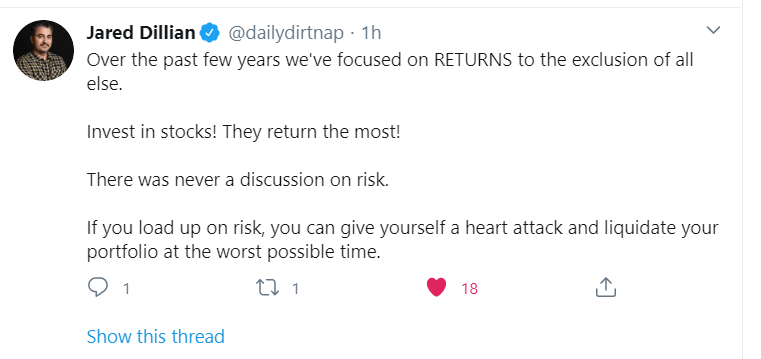Before we jump into a report card on how digitization of sourcing performed during the Covid-19 crisis, let’s think about what a framework would look like. One way to do this is to make an analogy to another business process and extend it to purchasing.
Paul Graham is an entrepreneur and investor focused on startups, but who deviates occasionally into philosophy.

Survival is the key to life, not just startups. As they used to say in Canada, “You have to be in it to win it.”
Similarly, Jared Dillian is an investor and commentator who writes extensively about public markets and who deviates occasionally into philosophy.

Ironically, the lesson we took away from the 2008 Global Financial Crisis (not to be confused with the 2020 Global Financial Crisis) is that we should focus on returns without thinking about risk.
In an earlier life, I spent a few years as a foreign exchange options market maker. I worked for several banks, managing portfolios of plain vanilla and then-exotic options across currency pairs with maturities within two years. I started just after the British pound fell out of the Exchange Rate Mechanism and I moved on around the time of the Asian Financial Crisis, having traded through events like the Mexican Crisis, the Quebec Separation Referendum, and a putative Russian coup.
It was great training. It was even more fun. It was a wonderful thing to do as a young man.
The market is a harsh teacher. As a dealer, you’re making markets to various clients some of whom are laying off risk for you to manage and some of whom are taking risk off your hands so they can earn a fee for doing so. Dealers earn a bid/offer spread for providing liquidity.
You win or you lose, you live or you die, by making sure that the market isn’t stuffing you full of risks that are beyond your capacity to handle without paying you enough to take the pain.
You learn very quickly to take only risks that you understand and to be vigilant for bets that you didn’t realize you were taking, or whose scale you may be underestimating. These risk holes can be lethal.
The best risk managers in financial markets dump these risk holes on others willing to take them for a reasonable price.
The corollary point here is that you need liquidity, too. You need to have the relationships in place so that people will work with you when things get rough. And you need to have enough relationships to diversify the possibility that some people will close their doors to you when you need help the most.
Why is the analogy to financial markets appropriate?
Because the grand lesson of the Covid-19 crisis is that sourcing and procurement should be thought of as risk management, first and foremost.
Thinking of sourcing as a transactional process meant that companies ignored the need for a margin of safety and focused exclusively on lowering costs, just as investors fixated on returns, even if that meant taking extraordinary risk of being forced to sell at lower prices, permanently destroying capital. For every Bayer that practiced “just-in-case” acquisition, there were hundreds focused on “just-in-time” purchasing.
Knowing what we all know now, how would you design the perfect sourcing setup?
Manage Risk Firmwide: Sourcing needs to be part of a firmwide conversation about risk. There are people in product, sales, marketing, finance, and operations who receive intelligence about different markets. When they hear rumblings about a weird virus in China, sourcing should know straightaway to be able to react nimbly.
Build Relationships: It is vital for sourcing to cultivate good relationships with suppliers. When supplies get constrained, vendors will take care of their best customers first. Anyone who treated them in an adversarial way beforehand will get the adversarial treatment themselves when it matters most.
Onboard Rapidly: During a crisis like this one, buyers will need to identify, vet, and onboard new suppliers as quickly as possible. Having a bureaucratic process will ironically increase the firm’s risk.
Standardize: Standardize processes and make it easy and predictable for your suppliers. The more obstacles you can remove the better.
Collaborate: Collaborate with your suppliers to help them help you. Find others in different sectors who purchase the same goods and services and work with them to improve outcomes. Work cooperatively with your competitors, too. They aren’t going to learn anything from your sourcing operation that they don’t already know or can’t already figure out.
Diversify: Diversify your suppliers by geography. Don’t concentrate your purchasing with one vendor just for the sake of getting marginally lower unit costs.
Simulate: Use structured data to simulate different scenarios. How did your suppliers perform during the SARS crisis? How did they perform during the tsunami? During a great blizzard? During the 2008 crisis?
Build a Margin-of-Safety: Build a cushion of inventories for key inputs.
None of these things were part and parcel of the digital approach to sourcing before the crisis.
Digitization, it turns out, was just purchasing bureaucracy 2.0.
Of course, the events of 2020 have been unprecedented. A risk management approach to sourcing that worked well would have mitigated the damage, not eliminated it. But, as the old joke goes, you don’t have to run faster than the bear you meet in the woods. You just have to run faster than the other people.
If you want to talk about the tools that you can use to supplement your existing investment in digital tools for procurement, while enabling you to put in place risk management measures such as firmwide risk management, collaboration, diversification, and data-driven decision-making, give us a shout. Come check us out for a free trial.




